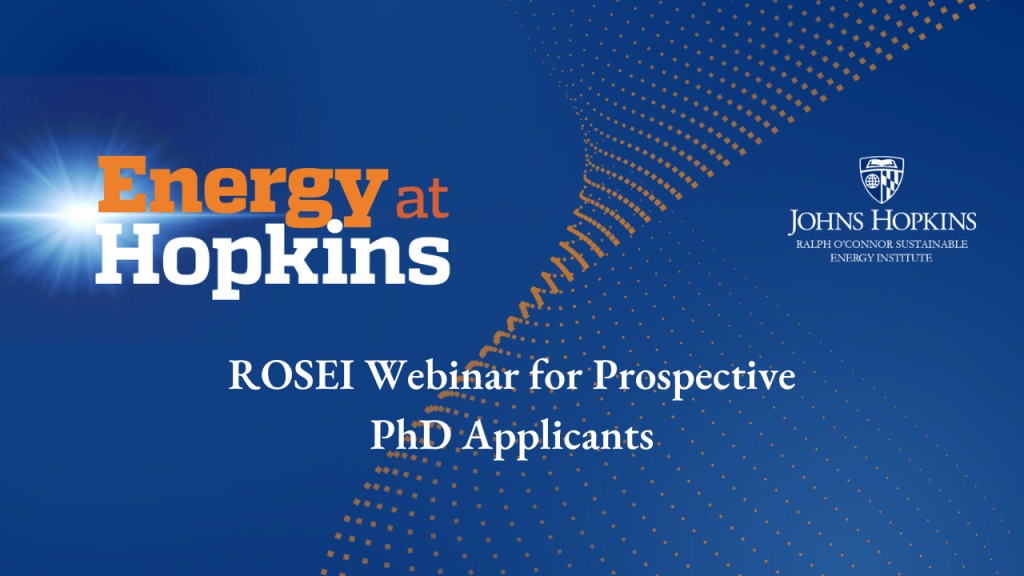November 1, 2023
6:00 pm
Thank you to those who registered and attended the 2023 ROSEI Webinar for Prospective PhD Applicants! See below for slides and video of the event.
Video:
PowerPoint (for download)
ROSEI PhD recruitment event 23
ROSEI FAQ
Skip to PDF contentStudents interested in pursuing a PhD in the sustainable energy field, please join the Ralph O’Connor Sustainable Energy Institute (ROSEI) for a webinar about PhD study opportunities at Johns Hopkins University (JHU). The webinar is set to take place on November 1 at 6 PM ET and requires registration.
The webinar will cover a variety of topics, including:
- An overview of ROSEI
- An overview of JHU admission process
- Fellowship opportunities
- Networking with faculty from ROSEI’s pillars – Carbon, Storage, Wind and Grid – and speaking with them about their respective research areas
- A Q&A session
ROSEI is a community of researchers at JHU that is committed to advancing sustainable energy, and we would love for you to join us. PhD programs are housed within the academic departments at JHU, so PhD students working in sustainable energy span many parts of the university. As a student interested in doctoral research and in sustainable energy, ROSEI would love to help you find a home at JHU.
See below to learn more about some of the research being conducted in each of ROSEI’s four pillars. Questions about the webinar can be sent to energy@jhu.edu with the subject line “Prospective PhD Applicant Webinar Question.”
Carbon

Combatting carbon dioxide output is one of the main pillars ROSEI is founded upon. ROSEI’s main focus in this area is on a novel attempt at extricating the carbon in CO2 and converting it into a form of solid carbon useful in applications ranging from farming to construction. Led by ROSEI core researchers Jonah Erlebacher and Chao Wang, these efforts are house under an initiative titled “Negative Carbon Carbon (NC2).”
“If we can do this, we would be the first in the world to demonstrate a complete carbon-to-carbon route, in which so-called ‘bad carbon’ is transformed into a globally useful ‘good carbon,’” Erlebacher says.
Storage

ROSEI’s main work in this area is funneled through the Light-Integrated Technology for Energy Storage (LITES) Initiative, which is attempting to use two different methods to expand solar energy’s uses. The first method involves the creation of new flexible, lightweight, high-efficiency solar technology with light-collecting capabilities, while the second focuses on photobatteries, which integrate two functions into one device without sacrificing either energy generation or storage performance. The research is led by a trio of ROSEI leadership council members: Jeff Maranchi, Sara Thoi and Susanna Thon.
“We aren’t trying to come up with just incrementally better ways to store solar energy; we’re attempting to establish a whole new paradigm for solar energy where the generation and storage are integrated into one system,” Thon says.
Wind

Wind power is rising. Having grown from supplying less than 2 to over 8% of US electricity in only a few years, this renewable source of energy is a disruptive technology that can help usher in a sustainable energy future. One impediment to increasing reliance on this clean, sustainable power source is the vast size of many windfarms and the challenge of understanding turbine-turbine and turbine-atmosphere interactions. These interactions affect wind farm performance on a variety of levels—from power output to turbine loading and maintenance.
High performance computer simulations can help by providing detailed insights into fluid mechanical effects associated with turbine placement, layouts, and environmental factors. Led by Dennice Gayme and Charles Meneveau, ROSEI has started an initiative focused on creating a public database of windfarm simulations, which will allow anyone with an internet connection to easily access and analyze the data in order to conduct research, generate knowledge, and evaluate models or wind field data to be used in wind farm planning or development projects.
Grid

The purchase and delivery of power through a grid that relies almost entirely on renewable energy and new paradigms for energy storage is vastly different from today’s grid. Our team is developing a complete power systems laboratory utilizing a simulation and hardware-in-the-loop platform that will interface software solutions developed by the ROSEI team – such as models and algorithms for efficient power grid and market operations – with a robust simulator emulating an inverter-dominated power grid. The focus on high-impact and high-visibility applications distinguish this ROSEI Research Initiative from other testbeds. We are also working with partners to bring these solutions to today’s power systems as expediently and equitably as possible.
Faculty leaders in this area include Yury Dvorkin, Dennice Gayme, Sijia Geng, Ben Hobbs, and Enrique Mallada. This group of five are also leaders of the Electric Power Innovation for a Carbon-free Society (EPICS) Center, an NSF-funded international center based out of ROSEI that will develop computing, economic, engineering, and policy methods and tools to enable a 100% emissions-free power grid.
